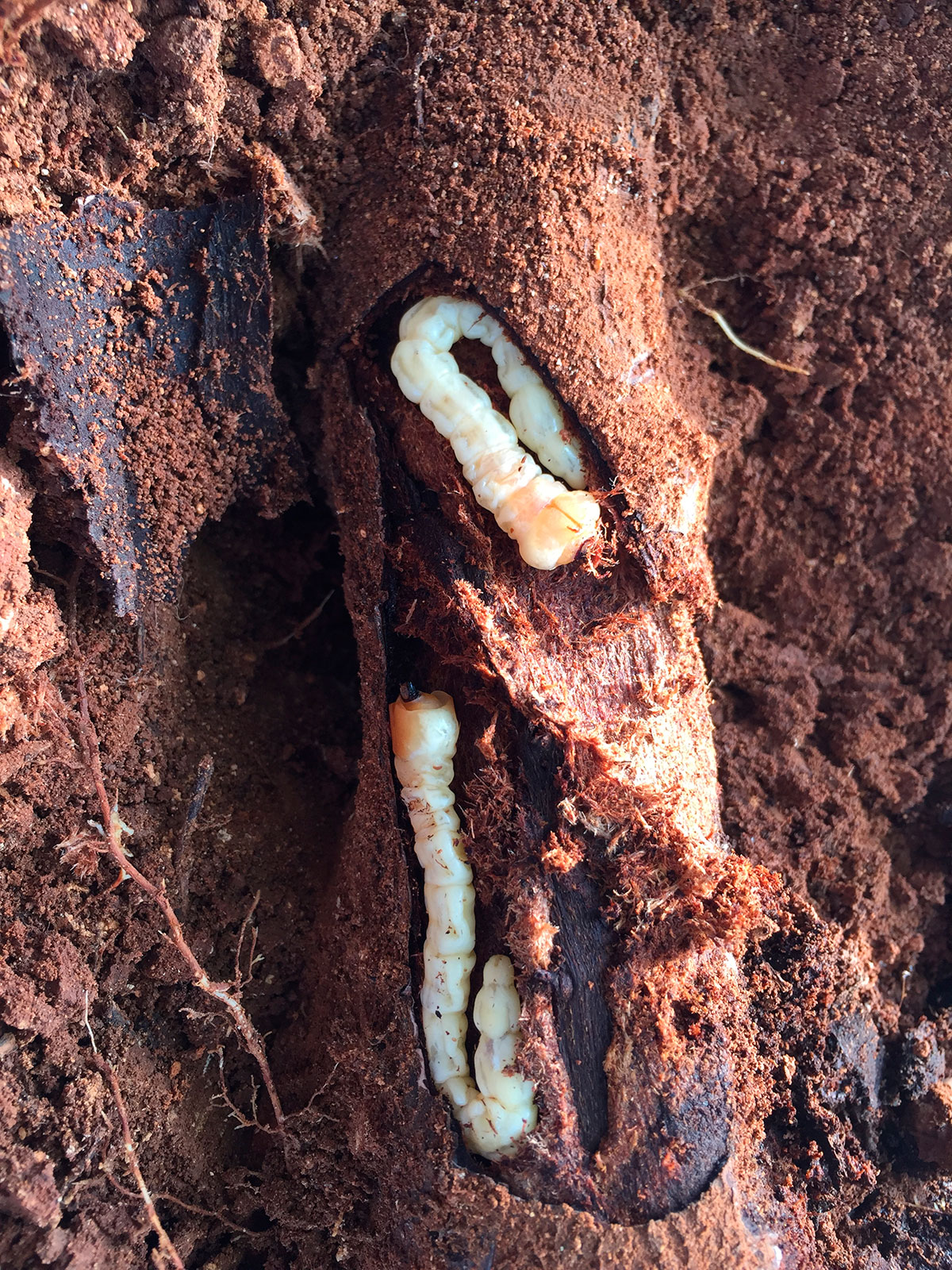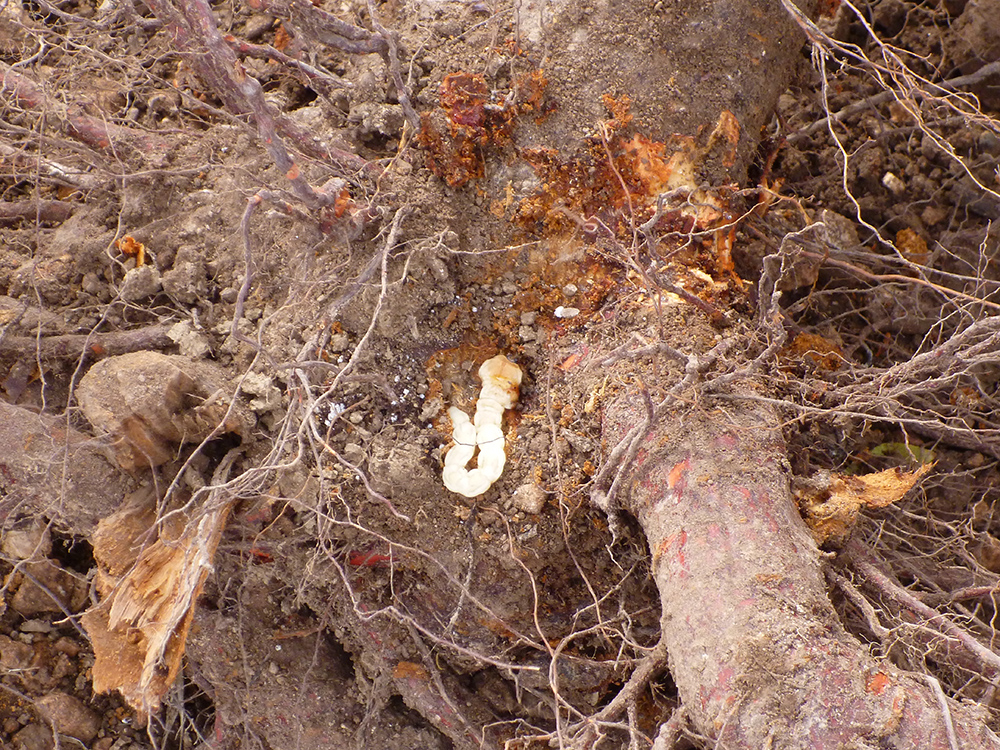
Big-Headed Worm
Capnodis Tenebrionis
Pathogène :
Insect
Type:
Risque:
HIGH
Orugas o gusanos


¿QUIÉN LO CAUSA?
Capnodis tenebrionis, known as the big-headed worm, is a beetle that mainly affects stone fruit trees such as almond trees. Adults emerge in early summer and feed on the bark of young branches. Females lay eggs at the base of trees, usually in the soil near the roots. The larvae emerge and penetrate the soil, where they look for the main roots of the almond tree to feed. These larvae have a prolonged underground phase, often two to three years, during which they feed and grow, causing significant damage to the roots. Once their development is complete, the larvae pupate in the soil and emerge as adults, completing the cycle. This pattern can repeat several times a year depending on weather conditions and host availability.
SÍNTOMAS
In the almond tree, the bigheaded worm causes damage to both the roots and the aerial part of the tree, weakening its structure and compromising its productivity. Larval damage to taproots interferes with nutrient and water uptake, which can lead to overall weakening of the tree.
- Yellowing and wilting of the leaves.
- Reduction in the growth and vigor of the tree.
- Appearance of rubber at the base of the trunk.
- Drying of branches and regressive death.
- Visible damage to the bark of young branches.
- Presence of galleries in the main roots.
- Loss of productivity and quality of the fruits.

TEMPERATURA Y HUMEDAD
25°C - 30°C
60% - 80%
VÍAS DE TRANSMISIÓN
Direct contact between plants, Movement of infested plants, Wind, Infested soil
Do you want to remove this pest? Choose how you want to treat it.
TRATAMIENTOS
Tratamientos químicos
• ACETAMIPRID 20% [SL] P/V
• ACETAMIPRID 20% [SP] P/P
• ACETAMIPRID 20% [SG] P/P
• DELTAMETHRIN 1.57% [SC] P/V
• ACETAMIPRID 20% [SP] P/P
Tratamientos permitidos en agricultura ecológica
-
Tratamientos biológicos
-
Recomendaciones
- Carry out regular monitoring to detect the presence of adults and larvae.
- Keep the ground around the trees clean and free of weeds that could serve as shelter.
- Apply chemical treatments to the soil around the base of the trunk to control larvae.
- Use pheromone traps to catch adults and reduce their population.
- Implement adequate irrigation practices to avoid water stress, which can predispose trees to attack.
- Promote biodiversity in the garden to encourage the presence of natural enemies of the big-headed worm.
- Apply biological products such as entomopathogenic nematodes to control larvae in the soil.
- Carry out correct pruning and removal of affected branches to reduce egg laying sites.
Enlace patrocinado
Enlace patrocinado
Enlace patrocinado
Enlace patrocinado
Enlace patrocinado
Enlace patrocinado
Effective against all types of fungi
TRATAMIENTOS
Remèdes maison
There are no home treatments
Alliés naturels
Traitements chimiques
There are no treatments for this disease. Treatments are directed at the insect vectors that transmit it. See insect treatments.
RECOMMANDATIONS
- Check the back of the leaves frequently, especially in dry weather.
- Spray water on the leaves to increase humidity and prevent them from settling.
- Keep plants healthy with good watering and adequate light.
- If you see cobwebs or damage, clean the leaves with a damp cloth or pressurized water.
- Use potassium soap or neem oil every few days until they disappear.
Plantes répulsives
Rosemary, Dill, Coriander
PRODUITS RECOMMANDÉS
Enlace patrocinado
Enlace patrocinado
Enlace patrocinado
Enlace patrocinado
Enlace patrocinado
Enlace patrocinado
Effective against all types of fungi
*Los tratamientos recomendados no dejan de ser recomendaciones según las bases de datos de las autoridades y en ningún momento sustituyen las directrices marcadas según la legislación de cada país
*Les produits présentés sont des recommandations et ne sont pas nos propres produits. En tant qu'associés Amazon, nous gagnons des revenus grâce aux achats de produits recommandés.






















